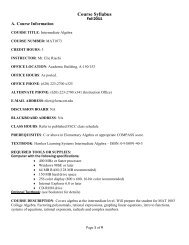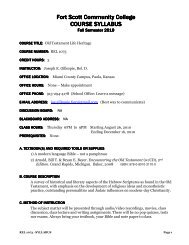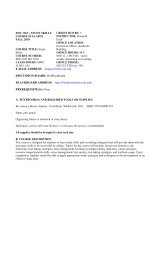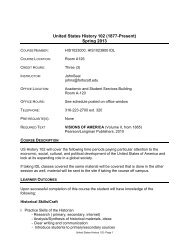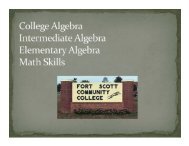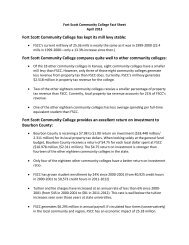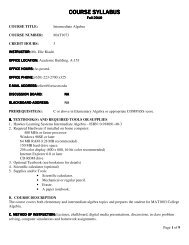Course Syllabus - Fort Scott Community College
Course Syllabus - Fort Scott Community College
Course Syllabus - Fort Scott Community College
You also want an ePaper? Increase the reach of your titles
YUMPU automatically turns print PDFs into web optimized ePapers that Google loves.
A. <strong>Course</strong> Information<br />
<strong>Course</strong> <strong>Syllabus</strong><br />
Spring 2012<br />
COURSE TITLE: Intermediate Algebra<br />
COURSE NUMBER: MAT1073<br />
CREDIT HOURS: 3<br />
INSTRUCTOR: Mr. Elie Riachi<br />
OFFICE LOCATION: Academic Building, A-150/153<br />
OFFICE HOURS: As posted.<br />
OFFICE PHONE: (620) 223-2700 x3250<br />
ALTERNATE PHONE: (620) 223-2700 x3410 (Instruction Office)<br />
E-MAIL ADDRESS: elier@fortscott.edu<br />
DISCUSSION BOARD: NA<br />
BLACKBOARD ADDRESS: NA<br />
CLASS HOURS: Refer to published FSCC class schedule<br />
PREREQUISITES: C or above in Elementary Algebra or appropriate COMPASS score.<br />
TEXTBOOK: Hawkes Learning Systems Intermediate Algebra – ISBN: 0-918091-40-3<br />
REQUIRED TOOLS OR SUPPLIES:<br />
Computer with the following specifications:<br />
400 MHz or faster processor<br />
Windows 98SE or later<br />
64 MB RAM (128 MB recommended)<br />
150 MB hard drive space<br />
256 color display (800 x 600, 16-bit color recommended)<br />
Internet Explorer 6.0 or later<br />
CD-ROM drive<br />
Optional Textbook: (see bookstore for details)<br />
COURSE DESCRIPTION: Covers algebra at the intermediate level. Will prepare the student for MAT 1083<br />
<strong>College</strong> Algebra. Factoring polynomials, rational expressions, graphing linear equations, intro to functions,<br />
systems of equations, rational exponents, radicals and complex numbers.<br />
Page 1 of 10
B. METHOD OF INSTRUCTION:<br />
Lectures, discussions, problem solving demonstrations, computer simulations, homework assignments and tests.<br />
C. COURSE COMPETENCIES/OBJECTIVES:<br />
The following standard outcomes are expected:<br />
1. To help the student develop skills which will enable him or her to solve problems and communicate<br />
effectively using the language and techniques of algebra.<br />
2. To acquaint the student with some of the general concepts and principles of mathematics that will<br />
serve as a basis for further studies in mathematics.<br />
3. To help the student build confidence in his or her ability to solve problems in mathematics.<br />
4. To encourage the student to develop and use a sound mathematical vocabulary.<br />
D. COURSE TOPICS/UNITS:<br />
Formulae, Applications and Solving Linear Inequalities with Absolute Values (Unit 1: 1.3a, 1.5a, 1.6, 1.7a,<br />
1.7b):<br />
1. Absolute values<br />
2. Evaluating formulae<br />
3. Applications of algebra<br />
4. Solving linear inequalities<br />
5. Solving absolute value inequalities<br />
Linear Equations and Functions (Unit 2: 2.2, 2.3a, 2.3b, 2.4, 2.5):<br />
6. Graphing linear equations in slope-intercept form<br />
7. Finding the equation of a line<br />
8. Graphing linear equations in point-slope form<br />
9. Introduction to functions and function notation<br />
10. Graphing linear inequalities<br />
Systems of linear equations (Unit 3: 3.1b, 3.1c, 3.2):<br />
11. Solving systems of linear equations by substitution<br />
12. Solving systems of linear equations by addition<br />
13. Applications of systems of linear equations<br />
Exponents and polynomials (Unit 4: 4.5b, 4.6b, 4.7a, 4.7b, 4.8):<br />
14. Factoring by grouping<br />
15. Factoring trinomials by the ac-method<br />
16. Special factorizations – squares<br />
17. Special factorizations – cubes<br />
18. Solving quadratic equations by factoring<br />
Rational expressions and rational equations (Unit 5: 5.1b, 5.2, 5.3, 5.4, 5.6)<br />
19. Multiplication and division with rational expressions<br />
20. Addition and subtraction with rational expressions<br />
21. Complex fractions<br />
22. Solving equations with rational expressions<br />
23. Applications: variation<br />
Roots, radicals and complex numbers (Unit 6: 6.1b, 6.2, 6.3a, 6.3b, 6.3c, 6.4, 6.6, 6.7):<br />
24. Simplifying radicals<br />
25. Rational exponents<br />
26. Addition and subtraction with radicals<br />
27. Multiplication with radicals<br />
28. Rationalizing denominators<br />
Page 2 of 10
29. Solving radical equations<br />
30. Complex numbers<br />
31. Multiplication and division with complex numbers<br />
Quadratic equations and quadratic functions (Unit 7: 7.2, 7.5, 9.3 distance formula only):<br />
32. The quadratic formula<br />
33. Graphing parabolas<br />
34. Distance formula<br />
E. UNIT COMPETENCIES/OBJECTIVES:<br />
This section is from Kansas Core Outcomes Project 2010-2011. It is assumed that students entering an<br />
Intermediate Algebra course will have competencies from prerequisite courses. Students will be expected to use<br />
appropriate technology as one tool to achieve the following outcomes:<br />
Arithmetic and Algebraic Manipulation<br />
Factor quadratic expressions, expressions of quadratic form, special forms, and factor by grouping.<br />
Perform addition, subtraction, multiplication, and division on rational expressions.<br />
Simplify complex fractions.<br />
Apply the laws of exponents to simplify expressions containing rational exponents.<br />
Apply the laws of radicals to perform addition, subtraction, and multiplication on expressions involving<br />
radicals. Rationalize denominators containing radicals.<br />
Simplify radicals containing negative radicands. Perform arithmetic operations on complex numbers.<br />
Evaluate functions using function notation.<br />
Equations and Inequalities<br />
Solve linear inequalities in one variable showing solutions both on the real number line and in interval<br />
notation.<br />
Solve literal equations, including those that require factoring.<br />
Solve systems of linear equations in two variables.<br />
Solve equations by factoring and quadratic formula.<br />
Solve equations containing rational expressions.<br />
Solve equations involving radicals.<br />
Solve linear absolute value equations and inequalities in one variable.<br />
Develop and solve mathematical models including variation, mixture, motion, work, and geometrical<br />
applications.<br />
Graphs on a Coordinate Plane<br />
Graph linear inequalities.<br />
Graph quadratic functions.<br />
Analysis of Equations and Graphs<br />
Determine an equation of a line given either sufficient information (two points) or a particular condition<br />
(perpendicular to a given line, parallel to a given line through a specific point, through a specific point<br />
with a given slope, etc.).<br />
Calculate the distance between two points.<br />
Distinguish between functions and relations using the Vertical Line Test.<br />
Identify the domain and range of a function given its graph.<br />
F. GRADING PLAN:<br />
Grading will be based on percentage system. All components within a category will have the same<br />
weight. A Student’s grade will have the following categories and weight for each category:<br />
Page 3 of 10
o Five unit tests and a comprehensive final test. These are in class pencil and paper tests. 80%<br />
o Homework assignments/in-class homework-based quizzes/in-class lecture-based quizzes 20%<br />
The lowest test score shall be dropped.<br />
A final percentage grade for the course is computed by adding the products of averages of earned<br />
percentages from each assessment category and its weight. The earned letter grade for the course will be<br />
the letter which corresponds to the range which the computed percentage belongs to according to the<br />
following scale: A: 100% - 90%; B: 89% - 80%; C: 79% - 69%; D: 68% - 50%; F: below 50%.<br />
In order to receive full credit for tests/assignments, the test/assignment must be completed by the date<br />
designated by the instructor.<br />
The students may check on their progress in the course by personally meeting with the instructor after<br />
class and during office hours.<br />
High test scores may increase the weight of the tests category and result in a higher letter grade for the<br />
course. The student is advised to do well on all tests to improve his or her grade in the course.<br />
A student could earn up to two percentage points, as bonus which is added to final grade for<br />
participation. These points will be tracked based on having perfect attendance and good classroom<br />
conduct. If you are not in class, then you are missing the opportunity to participate.<br />
Assignments must be turned in on time. Grade for late assignments will be reduced by a graduated<br />
penalty a maximum of twenty percentage points as setup in the Hawkes’ Learning System grade<br />
book.<br />
All paperwork (test, quiz, scratch paper and index card) used during a test or a quiz must be turned into<br />
the instructor at the end of the test or quiz and becomes the property of the instructor.<br />
Homework:<br />
The student will do the homework assignment on the computer. The student will only need to score 80% on the<br />
assignment and will receive 100%. The student will have the chance to redo problems similar to the ones<br />
missed so that the student can complete the assignment. The assignment maybe repeated as many times as you<br />
wish within the given time frame of the course (with penalty applied to late work as set by instructor). The<br />
student must have a computer. The student must also have access to the Internet to submit the certification.<br />
The student is able to do the assignment on the computer regardless whether or not the computer is connected to<br />
the Internet and save the certification to a flash drive and then transfer to computer with an Internet connection<br />
to submit the certificates for a grade.<br />
The student’s grade will be reduced 5% for each day the assignment is submitted late. The late penalty shall not<br />
exceed 20% no matter how late the assignment is. Assignments will not be accepted past the course end date as<br />
set by the instructor.<br />
In-class lecture-based quizzes:<br />
Pay attention during the lecture. There may be short quizzes given at any time during the lecture. These<br />
quizzes will be based on the contents covered in the lecture for that day. The student’s own notes and<br />
homework problems may be used as an aid during these quizzes.<br />
MAKE-UP:<br />
The instructor may consider giving a student a make-up for no more than one test or one quiz, during<br />
this course, provided that:<br />
o The student talked to the instructor about missing the quiz or test at least 30 minutes prior to<br />
the scheduled time of the assessment for which the make-up is being requested (or as soon as<br />
possible in the case of extenuating circumstances such as a car wreck. If you have a cell phone<br />
this would be an appropriate time to use it!) And;<br />
Page 4 of 10
o An emergency or an extenuating circumstance prevents the student from taking the test or quiz<br />
as scheduled. And;<br />
o The student provides the instructor with a valid proof of the emergency/ extenuating<br />
circumstance which prevented the student from taking the test/quiz as scheduled.<br />
The make-up shall assess the student over the same range of contents as the original assessment but not<br />
necessarily the same questions/problems.<br />
No outside material shall be used on a make-up other than the student’s calculator, writing and erasing<br />
implements and material provided by the instructor (INDEX CARDS MAY NOT BE ALLOWED ON<br />
MAKE UPS, CHECK WITH THE INSTRUCTOR IN ADVANCE).<br />
Partial credit and bonus points may not be available on a make up test<br />
It is the student’s responsibility to contact the instructor to make an appointment to take the make-up.<br />
The make-up must be taken within two days from the missed day.<br />
In the case of a prolonged illness with a doctor’s note or a student athlete excused by the Dean of<br />
Students, the student must take the make-up as soon as possible.<br />
All make-ups must be taken during the instructor’s office hours and will be proctored by the instructor.<br />
If the student fails to take the make-up as arranged, the student will earn a zero for the original<br />
assessment and no other make-up shall be given.<br />
The final test must be taken as scheduled and cannot be made up.<br />
G. ATTENDANCE POLICY: Attendance is required and will be recorded. Statistics show that students,<br />
who miss class frequently, are also likely to fail the course. A student will be counted absent for each time<br />
the student is not present for the whole class period. A whole class period begins with roll call and ends<br />
when the instructor dismisses the whole class.<br />
Being late:<br />
By being late the student misses important information which may also impede the student’s learning of<br />
consequent contents of the subject matter. It is also a distraction for the whole class and impacts it negatively<br />
when the student walks in late into the classroom. The instructor shall not waste class time to catch up late<br />
students on what they missed. A student missing role call will be counted absent.<br />
(Exceptions may be allowed for officially documented extenuating circumstances as deemed applicable by the<br />
instructor.)<br />
If the student wishes to withdraw from the course, it is recommended that the student discusses his or her<br />
options with the instructor before the last day to withdraw from the course (traditionally, this day has<br />
been the last weekday before the first day of finals.) It is the student’s responsibility to contact the<br />
counseling office weeks before the end of the semester to find out the date of the last day to withdraw<br />
from the course.<br />
H. COURSE COMPONENT SPECIFICS:<br />
Purchase the software required by your instructor. Please note that once you open the package, the materials are<br />
NOT refundable.<br />
TO INSTALL THE SOFTWARE AT HOME:<br />
1. Place CD #1 in the CD-ROM drive. (CD#1 is the only CD needed for the installation.)<br />
2. The installation will begin automatically. Follow the on-screen instructions.<br />
3. You will be prompted for a <strong>Course</strong> ID.<br />
-If you have internet access, select “Yes, the HLS <strong>Course</strong> ID is:” and enter <strong>Fort</strong><strong>Scott</strong>IMA<br />
-If you do not have internet access, select “No, I will not be accessing an online grade book from this computer”.<br />
Page 5 of 10
TO GET YOUR ACCESS CODE:<br />
1. Go to www.hawkeslearning.com and click on “get your access code” or click on the “I need an access code..." link from the<br />
software.<br />
2. Fill out the form (including your 15-digit license number on the yellow sticker on the CD sleeve). Click on the submit button<br />
and your personalized Access Code will appear on the screen. You will also receive an e-mail with the Access Code as an<br />
attachment called “access.cod” which you should save to a floppy disk or another device.<br />
TO ENTER THE SOFTWARE AND SAVE YOUR ACCESS CODE:<br />
1. Double-click on the purple diamond icon on the Desktop (or go to Start, Programs, Hawkes Learning Systems).<br />
2. Enter your Access Code when prompted. You may type it, paste it, or load it from disk (if you saved it) by clicking the “F1-<br />
Load From Disk” option and browsing to the path where you saved it. If you type or paste your Access Code, you will be<br />
prompted to save it. We recommend you save your Access Code to a floppy disk or another option to avoid typing it each<br />
time you enter the software.<br />
TO ENROLL IN YOUR INSTRUCTOR’S GRADE BOOK:<br />
1. If you have internet access and have entered your HLS <strong>Course</strong> ID (which is <strong>Fort</strong><strong>Scott</strong>IMA), you will be asked to enroll in<br />
your instructor’s grade book. Choose your instructor’s name and the correct section.<br />
2. If you do not have internet access, you will need to enroll in your instructor’s grade book by going to any computer that has<br />
an internet connection and go to www.hawkeslearning.com/<strong>Fort</strong><strong>Scott</strong>IMA. After entering your Access Code, you will be<br />
prompted to choose our instructor’s name and the correct section.<br />
TO CERTIFY (DO YOUR ASSIGNMENT IN THE SOFTWARE):<br />
1. The Certify option is where you will complete your assignment.<br />
2. After certifying, you will be given a certification code (this verifies that you completed your assignment). It is recommended<br />
that you print and/or save your certification code.<br />
3. a. If you have internet access, you should receive a message that says your certificate has been submitted in your<br />
instructor’s gradebook. You are now done with that assignment! If you do not receive this message, follow the directions<br />
under “b.”.<br />
b. If you do not have internet access, you will need to manually submit your certification code on the internet to get credit<br />
for your assignment in your instructor’s gradebook. To do this,<br />
- go to www.hawkeslearning.com/fortscottima and log in using your Access Code<br />
- click the Register Certificate(s) link<br />
- select the Lesson Name from the drop down list. Load from disk or type in your certification code and click OK. Your<br />
certification code is now submitted!<br />
- you need to perform these steps after you Certify to get credit for each of your assignments<br />
* Be sure you register your Certification Code ON or BEFORE the due date to get credit for the assignment.<br />
Student Directions for taking a Practice WebTest:<br />
1. Log into the Hawkes Learning Systems courseware using your access code.<br />
2. Click the button titled WebTest found on the bottom right-hand corner of the Table of Contents screen.<br />
3. Click on the Take Test button on the left hand side of the screen<br />
4. Select the Practice Test option and click OK.<br />
5. Choose the number of questions and click on No Time Limit.<br />
6. Choose the sections covered for the appropriate test by holding down the CTRL key.<br />
7. Take the test.<br />
8. When finished with the test, click End Test to submit your test results.<br />
9. You will be notified of your score immediately.<br />
10. Review your test (you can click on MISSED PROBLEMS ONLY at the bottom).<br />
11. Click on Data button on the left to see which sections you need more practice.<br />
12. When taking a practice test, you may only review the test immediately after taking it.<br />
13. Repeat as many times as you wish.<br />
<br />
Assignments due dates are accessed by clicking the progress report button in the Hawke’s<br />
computer program.<br />
Unit tests will be announced at least one week in advance.<br />
I. SERVICE LEARNING:<br />
Live tutoring is also available at www.kslc.org. You will need to obtain a library card which is available<br />
at the FSCC library.<br />
Page 6 of 10
J. CLASSROOM RULES OF CONDUCT:<br />
It is my goal to ensure that while you are in my classroom, you are in a safe, non-hostile and free<br />
of distractions environment that is conducive to learning:<br />
<br />
<br />
<br />
<br />
When the Instructor is talking, you are not;<br />
Raise your hand for your turn to speak;<br />
Be polite and be a friend;<br />
Be safe.<br />
Each student in this classroom shall exhibit mutual respect towards others in this classroom.<br />
Take care of your business before coming to class. If a student leaves the classroom when class is in session,<br />
that student is not to reenter the classroom until the class period has ended and the student will be counted<br />
absent for that class period. (Exceptions may be made in the cases of documented medical emergencies or<br />
conditions. But such exceptions must be approved by the instructor in advance before the class and during the<br />
instructor’s office hours.)<br />
Misconduct includes but not limited to: operation of a cell phone in class, chatting in class and cross talk<br />
without the instructor’s permission, foul language, singing, whistling, misuse of laboratory tools and equipment,<br />
horseplay and other behaviors and actions which are unrelated to course contents or are intended to disrupt<br />
class. No eating, drinking or tobacco use shall be permitted in the classroom. The consequences for<br />
misconduct, as deemed by the instructor, will vary from a verbal or written warning to the complete<br />
expulsion of the culprit student from the course with a grade of W or an F, regardless of what the<br />
student’s grade might have been up to the expulsion time.<br />
When a student is dismissed from class as a result of the student’s involvement in misconduct, then the student<br />
shall be counted absent for that class period.<br />
K. CELL PHONE USE:<br />
Cell phones must be TURNED OFF before entering the classroom. Cell phones must be stowed away and out<br />
of sight when in the classroom. The use of cell phones in class is not allowed, and is considered rude and<br />
disruptive. You will absolutely NOT be allowed to use the cell phone as a calculator under any circumstances<br />
in the classroom; BRING a REGULAR CALCULATOR to class.<br />
L. ACADEMIC INTEGRITY:<br />
The students and the instructor shall adhere to the highest moral and ethical academic standards. Honesty and<br />
integrity are at the core values of any educational establishment; deviation from such values destroys the<br />
foundation of such an institution.<br />
Dishonesty will not be tolerated. PDAs, MP3 players and cell phones must be stored out of view and must not<br />
be accessed at all times during a test. Use of any material other than that allowed by the instructor on a test will<br />
be considered an attempt to cheat. Do not talk to anyone other than the instructor during a test or a quiz even if<br />
you were done. Do not pass any kind of objects to another student during the test even if you were done. Do<br />
not talk out loud or whisper during the test even if you were done. If you need help raise your hand and the<br />
instructor will come to you. Failing to comply with the above will constitute cheating or attempting to cheat.<br />
Copying the reports of others and their assignments and turning them in as your own for credit is also<br />
considered cheating.<br />
Page 7 of 10
“Any student dishonesty detected in a course (including during examinations or in submitting plagiarized<br />
materials) may result in the student receiving no credit for the examination, written work or quiz, and<br />
may result in an F grade, suspension and/or dismissal from the course.”<br />
M. EMERGENCY PROCEDURES:<br />
a. Evacuation procedures: Exit the classroom quickly in an orderly and calm manner. Students<br />
in the front row exit first followed by the second row and so on until the last row of students<br />
have exited the classroom. Students are to assemble in the designated area as follows so that<br />
the instructor can get a headcount making certain that no student left behind:<br />
i. Tornado: each classroom should have a sign informing you of which room number has<br />
been designated as tornado shelter for your class room. Seek shelter in the designated<br />
room. Rooms that are designated tornado shelters should have a sign posted on the<br />
outside indicating their designation as a tornado shelter.<br />
ii. Fire: follow the evacuation procedures in “a”. Feel your way to find the safest route to<br />
the nearest exit. Assemble in the parking with your instructor for a headcount. DO NOT<br />
GO Back into the building.<br />
b. Lockdown: Stay in the classroom away from the field of view of windows. The classroom door<br />
is to be locked.<br />
c. Location of first aid kit: Faculty lounge.<br />
d. Universal Precaution Kit: Faculty lounge.<br />
e. Always follow the orders from official first responders.<br />
Information regarding Textcaster for alerts can be found at www.fortscott.edu<br />
Emergency contact phone numbers seem to change regularly. For updated numbers, please check<br />
www.fortscott.edu under About tab also under the Staff tab.<br />
Campus security: Emergency only – Phone: 1-620-224-7207<br />
Emergency 911<br />
Maintenance: Emergency only – Phone: 620-223-2700 ext. 471<br />
N. MISCELLANEOUS:<br />
The instructor will hold class as scheduled to present the contents of the course to the student in an instructional<br />
and professional manner. It is the student’s responsibility to learn the material being presented in this course<br />
by:<br />
Attending class regularly and on time;<br />
Paying attention to the lecture and asking the instructor questions during class and during instructor’s posted<br />
office hours to clarify the concepts which the student might be having difficulties understanding;<br />
Spending adequate time learning the material presented to you by reading the reference material required for<br />
this course and doing your homework and submitting it by the due date (it is recommended that the student<br />
spends 2 hours per week, on average, studying and doing homework for each 1 hour of class time.)<br />
Behave in a professional manner and make use of your college years to acquire knowledge and culture to help<br />
you achieve your career goals in life after college. Make your stay pleasant and respect others as you would<br />
expect them to respect you. Study hard and be proud of your achievements.<br />
Be a friend and be safe.<br />
O. TENTATIVE SCHEDULE:<br />
Assignment due dates will be announced in class.<br />
Page 8 of 10
A test may be expected every 3 to 4 weeks if not sooner. Test dates will be announced in class at least a week<br />
in advance. One good reason to never miss class!<br />
Note: This syllabus is subject to change at the discretion of the instructor. The material included is meant to<br />
provide an outline of the course and rules that the instructor will adhere to in evaluating the student. However,<br />
this syllabus is not intended to be a binding legal contract.<br />
Page 9 of 10
Sign this page, detach from syllabus, and return to instructor.<br />
COURSE TITLE: Intermediate Algebra<br />
Spring 2012<br />
COURSE NUMBER: MAT1073<br />
CREDIT HOURS: 3<br />
INSTRUCTOR: Mr. Elie Riachi<br />
OFFICE LOCATION: Academic Building, A-150/153<br />
OFFICE HOURS: As posted.<br />
OFFICE PHONE: (620) 223-2700 x3250<br />
E-MAIL ADDRESS: elier@fortscott.edu<br />
Affidavit:<br />
My signature below indicates that I have read and understand this syllabus, and/or it has been<br />
made available either in hard copy or in an electronic format through the website and/or<br />
Blackboard.<br />
[Instructor may add specific statements related to his/her course.]<br />
______________________________________<br />
Student Signature<br />
_______________<br />
Date<br />
______________________________________<br />
Print Name<br />
______________________________________<br />
Print e-mail address*<br />
_________________________________<br />
Cell phone number*<br />
*Students must provide the Registrar’s Office with updated contact information.<br />
Page 10 of 10



